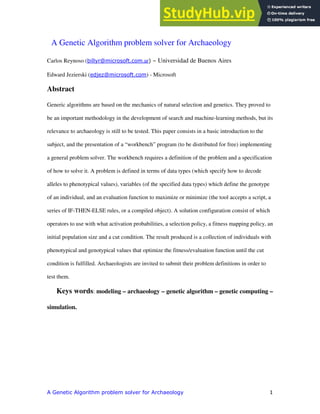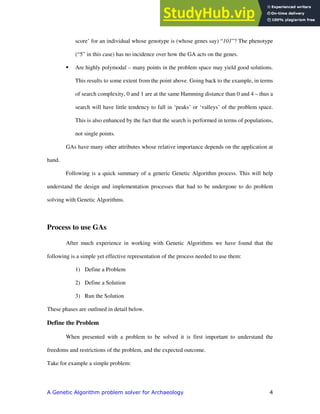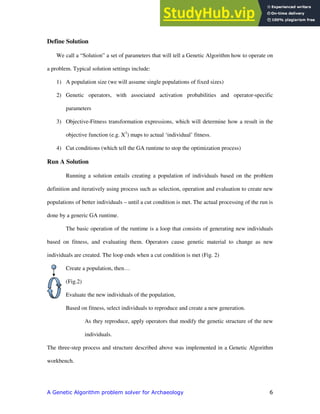This document introduces a genetic algorithm workbench that can be used to solve archaeology problems. Genetic algorithms are inspired by natural selection and use populations of individuals that evolve over generations to optimize solutions. The workbench allows users to define problems in terms of data types and variables, and evaluate solutions. It implements genetic operators like selection, crossover and mutation to iteratively improve populations. Archaeologists are invited to test genetic algorithms on their problems by using the freely available workbench.




![!
Find X such that X2
is the highest, with x being natural numbers between –2 and 5
From here we can infer that:
We want to search (or optimize - a premise for GA use)
The search is done on a number of X’s,
The Xs are samples on a continuous dimension,
The dimension is bound between –2 and 5 and has 7 samples,
We are searching for a result of X2
,
We want to maximize the result.
For most cases, the following approach – implemented in our Genetic Algorithm
workbench– covered the definition of most problems we were encountered with during a number
of research activities.
1) Identify Data Types for the Problem
a. Identify type – Continuous or categorical
b. Identify data type values – classes or bounds & samples
2) Identify variables that belong to certain data types
3) Express a transformation that will express fitness in terms of those variables and other
context information. This can be done by
a. A generic function, script, program or object
b. A set of rules of the form: if [condition] then [deltaT] else [deltaF]
4) Express the desire to maximize or minimize the fitness function.
An individual is then merely a representation of a solution. This representation is not done in
terms of the problem variables but in terms of a problem independent alphabet. For ease of
understanding in this paper we will assume that it is a binary alphabet (of 1’s and 0’s). For
simplicity we will also assume the alphabet is known a priori and is constant. In the example
above, an individual could be defined as three 1’s and 0’s: (-2=000, -1= 001, … , 4=110, 5=111).](https://image.slidesharecdn.com/ageneticalgorithmproblemsolverforarchaeology-230805170414-f4275d1a/85/A-Genetic-Algorithm-Problem-Solver-For-Archaeology-5-320.jpg)






